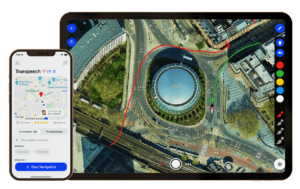Roundabouts can be tricky, but with the right knowledge, you can navigate them with ease and confidence on your driving test. Types of roundabouts vary across the UK, and understanding how to approach each one is essential to passing your driving test and driving safely. In this blog, we’ll cover the types of roundabouts you may encounter, how to navigate them, and tips for handling them confidently on the road.
Types of Roundabouts: Key Features to Understand
Roundabouts are designed to keep traffic flowing safely, but they can cause confusion, especially for new drivers. Here are the most common types of roundabouts you’ll encounter and tips on how to approach them:
1. Mini Roundabouts
Mini roundabouts are typically used in residential areas to keep traffic moving at a safe speed. These roundabouts are smaller in size, often with a painted circle in the middle, and are designed for lower speeds.
How to Navigate Mini Roundabouts:
- Yield to the right: Like all roundabouts, give way to traffic coming from your right.
- Stay in your lane: Mini roundabouts are usually straightforward with one lane, but always keep your vehicle within the markings.
- Be aware of cyclists and pedestrians: These roundabouts often serve local streets, so be extra cautious for other road users.
2. Standard Roundabouts
The most common type of roundabout, the standard roundabout, is typically used at intersections where traffic flows from multiple directions. These roundabouts vary in size and have clear markings to direct traffic.
How to Navigate Standard Roundabouts:
- Yield to the right: Always give way to traffic coming from the right unless directed otherwise.
- Signal appropriately: Use your indicator when turning left or right and when exiting the roundabout.
- Be mindful of lane discipline: Standard roundabouts often have two or more lanes, so choose your lane based on your exit.
3. Large Roundabouts
Large roundabouts are usually found in busy urban areas or along dual carriageways. They can be more complex due to multiple lanes and higher traffic speeds.
How to Navigate Large Roundabouts:
- Choose your lane early: You may need to be in the left lane for a left exit, or the right lane for a right exit, so plan your lane in advance.
- Signal early and consistently: Use your indicators as you approach and exit the roundabout.
- Be aware of multiple lanes: If you’re changing lanes on the roundabout, be sure to check your mirrors and blind spots before moving.
4. Multi-Lane Roundabouts
Multi-lane roundabouts are designed for high-traffic areas, where multiple lanes are required to keep traffic moving smoothly. These roundabouts are larger than standard ones and may have exits leading to dual carriageways or motorways.
How to Navigate Multi-Lane Roundabouts:
- Know your exit: Before approaching the roundabout, check the road signs for the correct lane.
- Signal appropriately: Use your indicators for both approaching and exiting the roundabout.
- Be aware of lane changes: If you’re changing lanes on the roundabout, be sure to check your mirrors and blind spots before moving.
How to Prepare for Roundabouts on Your Driving Test
Navigating types of roundabouts can be tricky for learners, but with these tips, you’ll be able to approach them confidently:
1. Always Yield to the Right
This is a fundamental rule when driving on roundabouts in the UK. You must always give way to traffic coming from your right unless road signs indicate otherwise.
2. Use Your Indicators Early
When exiting a roundabout, signal well in advance to inform other road users of your intentions. Remember to indicate left when exiting, but only when it’s safe to do so.
3. Know Your Lane
On multi-lane roundabouts, it’s essential to choose the correct lane before you enter the roundabout. You should stay in your lane while navigating the roundabout and exit in the same lane unless road markings suggest otherwise.
Practice with RouteBuddy
One of the best ways to prepare for roundabouts is to practice on real-world routes. RouteBuddy helps you practice test routes, including roundabouts, in your local area. It allows you to get familiar with the types of roundabouts you’ll encounter on your driving test and helps you build confidence. By using RouteBuddy, you can virtually experience navigating roundabouts before test day.
Practice driving test routes with RouteBuddy!
Conclusion: Navigating Roundabouts with Confidence
Knowing the types of roundabouts and how to approach them is key to your success on the road and in your driving test. Practice makes perfect, so take the time to familiarise yourself with the types of roads and roundabouts in your area. By following these tips and using tools like RouteBuddy, you’ll improve your confidence and be ready to tackle any roundabout during your test.
FAQs for Types of Roundabouts
1. What are the main types of roundabouts?
The main types of roundabouts are mini, standard, large, and multi-lane.
2. How do I navigate multi-lane roundabouts?
Choose your lane early, use your indicators consistently, and be aware of other road users when entering or exiting the roundabout.
3. Can RouteBuddy help with roundabout practice?
Yes! RouteBuddy offers driving test routes that include roundabouts, helping you practice for the test with real-world conditions.
4. What should I remember when driving on a roundabout?
Always yield to the right, signal early, and stay in your lane until it’s time to exit.
Start your practice today with RouteBuddy!



